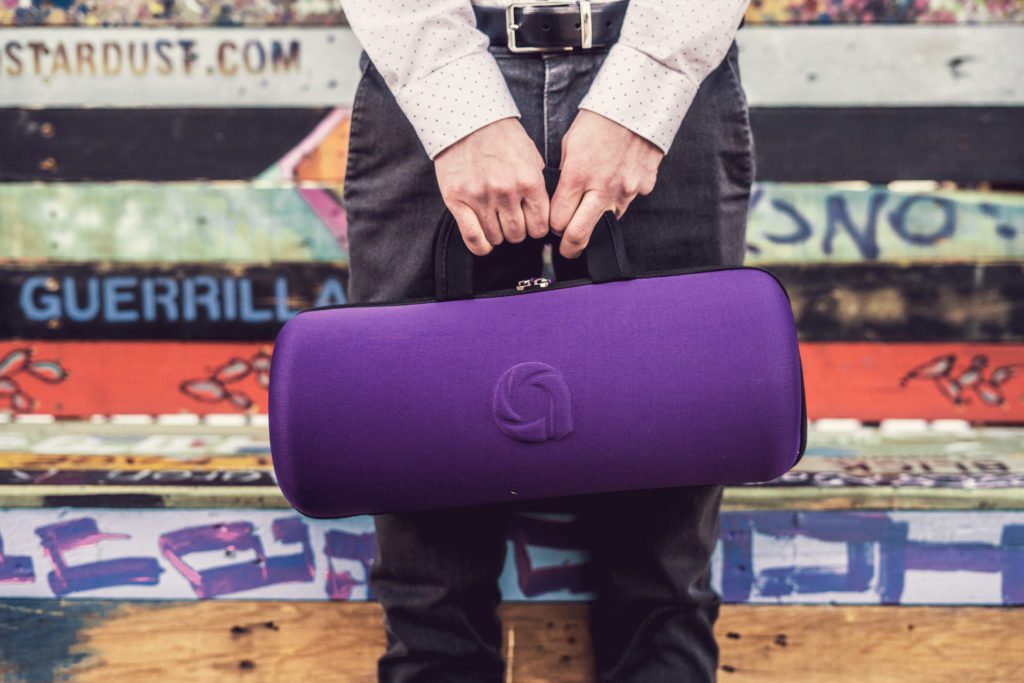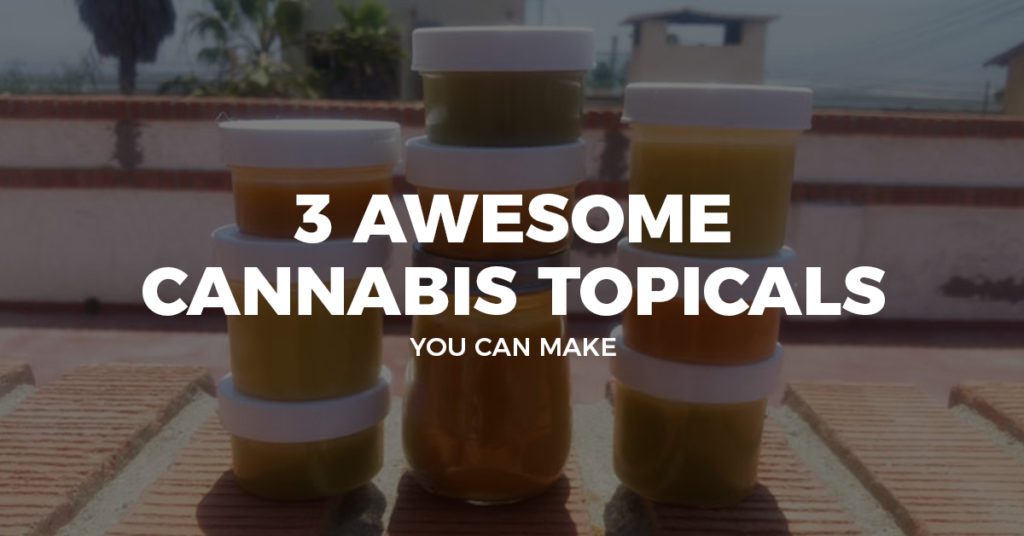
A lot of people do not understand cannabis topicals. They find it hard to believe that rubbing cannabis on your skin can possibly provide relief.
It might sound like magic, but there is solid science behind it. That’s because our skin contains a proliferation of cannabinoid receptors. The cannabis in the topical binds to the cannabinoid receptors in the skin and provides localized relief from pain, inflammation, and various skin conditions.
Topical cannabis does not cross the blood barrier. That means you won’t get high or fail a drug test from using it.* This is also why cannabis topicals provide localized, as opposed to systemic, relief.
The exceptions to this rule are the specially-made transdermal patches that do have ingredients that allow cannabis to penetrate beyond the skin, but that is not what we are talking about for the purposes of this article.
You might think it’s complicated to make topicals. But once again you would be mistaken. If you can make cannabis-infused oil, you can make cannabis topicals. And if you don’t know how to make cannabis-infused oil, this link will show you how. Using the FX or the Mini it’s super simple!
*while it is unlikely that you will fail a drug test from using topicals if the topicals contain THC and are inadvertently ingested, it could cause them to show up on a drug test.
TABLE OF CONTENTS
Oil, the Key to Cannabis Topicals
Cannabis-infused oil is the key. Most topical products contain oil. When making topicals, we infuse the oil to carry the cannabinoids and other beneficial compounds from the plant into the topical.
The Best Oil for Topicals
There are a seemingly endless variety of carrier oils that can be used to make topicals.
For those who want to do a deep dive, each of these has slightly different characteristics. Some are better for aging skin, others better for those with skin conditions such as acne or psoriasis. Some stay solid at room temperature while others remain liquid. Some absorb into the skin quickly, others slowly. And all variations in between.
Don’t get overwhelmed by the options. And stay tuned for more guides on various oils and topical butters like cocoa and shea butter.
If you happen to have a favorite oil for your skin, by all means, use it. If not, for someone just beginning to experiment with cannabis topicals, coconut oil makes an excellent all-around choice.
Why coconut oil?
- It works well for most types of skin
- It’s moisturizing and soothing
- It’s antibacterial, antiseptic, and antifungal
- It has a pleasant scent
- It’s inexpensive
- It has the longest shelf life of all carrier oils – as much as 2 years!
Who should not use coconut oil topically?
Anyone with an allergy to coconuts and those with EXCEPTIONALLY oily skin. While coconut oil is generally beneficial to those with acne, those with SEVERE acne or oily skin may find it can clog pores. But for the rest of us, coconut oil makes a great choice when making topical cannabis products.
One other important note
Coconut oil is a solid at room temperature fat. For many topicals, such as the salve formula below, this is a big plus as it helps firm the consistency.
Other formulas, like the Bath Soaks below, work well with either solid or liquid oils.
For the massage oil formula, on the other hand, you will want to maintain a liquid consistency. Regular coconut oil would not work. For topicals like this, substitute MCT (Medium Chain Triglycerides) Coconut Oil, as this will stay liquid at room temperature. Find it at natural foods stores.
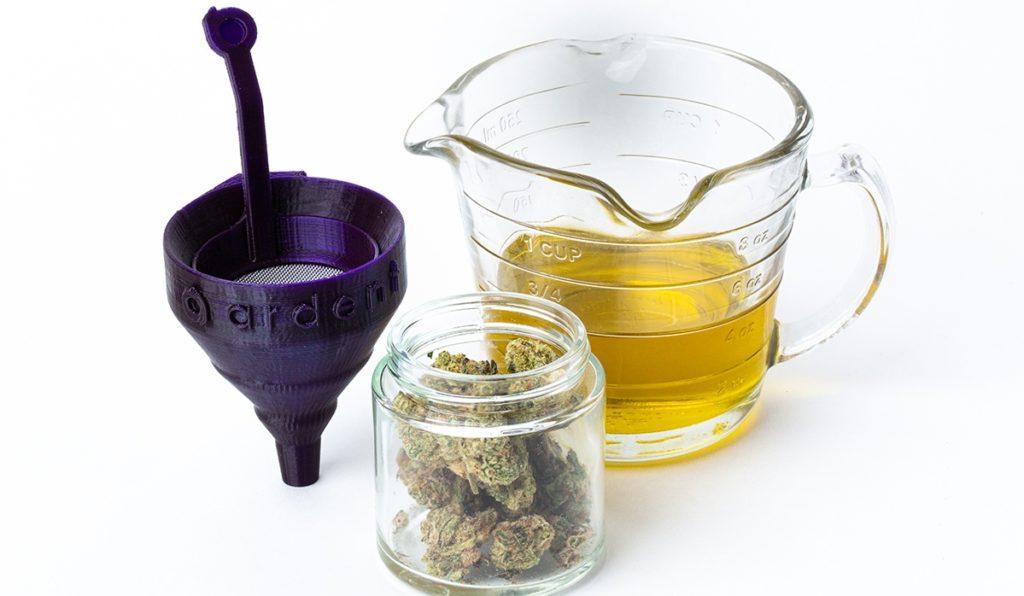
Notes About Using Essential Oils
Adding scents with Essential Oils can customize cannabis topicals to your own personal preferences. Not to mention, using these oils to create your own fragrances is lots of fun.
You can use a single scent such as lavender, rose, or peppermint, or combine several to make your own blend.
You could also purchase premade essential oil blends meant to deliver specific therapeutic effects such as congestion relief, stress reduction, relaxation, etc.
Be cautious and never add too much essential oil as they can irritate skin. For all over body formulas like those on this page, a 2% dilution is best. This converts to 12 drops of essential oil for every ounce of carrier oil. Of course, you can always add less.
If you use multiple oils you can use whatever ratio you like. Just make sure the total amount of essential oil does not exceed 12 drops per ounce of cannabis-infused carrier oil.
One more tip, when using essential oils, take a pin and poke a hole in a Vitamin E capsule and squeeze the contents into your topicals mixture. This is an optional step, but doing so will help preserve the scent.
3 Easy Cannabis Topicals Anyone Can Make with Infused Coconut Oil or MCT Coconut Oil
The first step in creating the topicals below is to prepare your cannabis-infused coconut oil. Don’t worry the process is easy, just follow the instructions in our guide. Now you’re ready to make some topical products!
The 3 projects below are super easy to make and will provide a great introduction to making and using cannabis topicals. But don’t let their simplicity fool you. They can provide significant relief from pain, inflammation, cuts, burns, and more.
They also make terrific DIY gifts, even for people who don’t normally use cannabis.
Project #1 – Cannabis Massage Oil
Cannabis Massage Oil is the easiest of all topicals to make. Honestly, you can simply use any cannabis-infused oil, as is, as a massage oil. But it is so much fun to add your favorite scents.
As a double bonus, both the person getting and giving the massage will receive therapeutic benefits. Giving massages can be tough on the hands, but by using a cannabis-infused massage oil you can simultaneously relieve some of that stress.
Also, don’t limit the use of this topical to ONLY when you get or give a massage. You can rub some into your skin anytime right where it hurts: knees, shoulders, elbows, hands, etc.
Packaging options for cannabis massage oils:
- Funnel into decorative bottles, especially nice for gifts.
- Plastic squeeze bottles make easy access when giving a massage, plus they won’t break.
- Rollerball bottles are handy for carrying along and let you roll on relief anywhere.
Cannabis Massage Oil Formula
- 4 ounces (1/2 cup) cannabis-infused MCT coconut oil or other liquid at room temperature oil
- contents of 1 Vitamin E capsule (optional but recommended if using essential oils)
- up to 48 drops of essential oils of choice (optional)
Add Vitamin E oil and essential oil to cannabis oil and mix. Package as desired.
Project #2 – Cannabis Bath Soaks
For the most soothing bath ever, treat yourself to a soak with cannabis bath salts!
Even without the addition of scents or colors, the combination of cannabis oil and Epsom salts provides relief for sore muscles, joint aches and pains, and even menstrual cramps.
A word of caution! These bath salts contain oil, which means that they can make your tub extra slippery. As with any bath oil, or oil containing bath product, take care getting in and out of your tub when using.
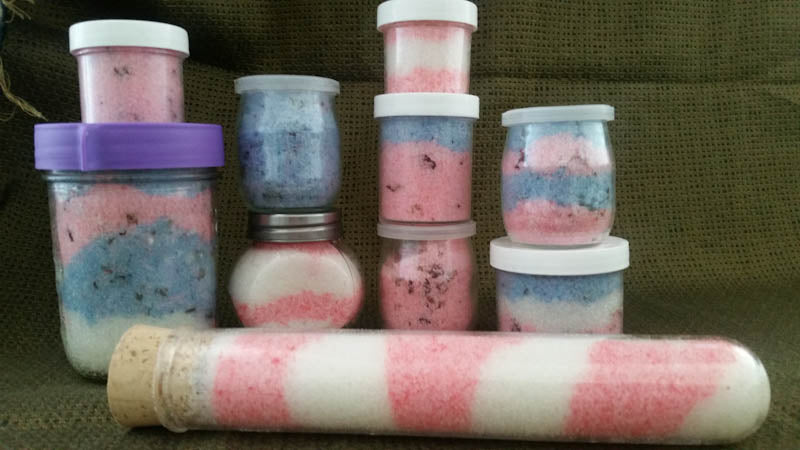
Cannabis Bath Soak Formula – enough for 4 baths
- 4 cups Epsom salts
- 1/4 cup cannabis-infused oil
- Contents of 1 Vitamin E capsule (optional but recommended if using essential oils)
- Up to 24 drops essential oil (optional)
- 2-4 drops liquid food coloring (optional)
- Dried herbs or flowers can add scents and visual interest to your bath salts but again, are not essential for function.
- In a small bowl mix together cannabis oil and if using, Vitamin E oil, essential oils, and food coloring.
Place Epsom salts in a larger bowl and pour oil mixture over them. Mix until everything is well combined. Package in jars.
Optionally, divide the mixture and add different colors and or flowers and dried herbs to different bowls; layer the colors and herb blends into jars for a decorative look.
Project #3 – Cannabis Salves
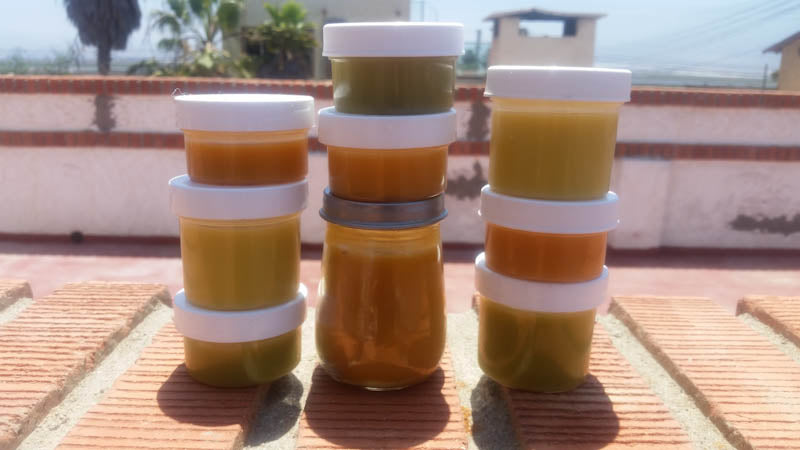
Salves are a semi-solid topical that soften as they touch the skin. Because of this texture, they are less messy than oils and easy to put into small jars or tins and take along.
You could eliminate the beeswax in the formula below as coconut oil is a solid at room temperature fat. However, it does turn to liquid pretty easily. Adding beeswax will hold the salve’s texture, except under extreme heat. It also adds even more moisturizing properties.
Packaging for Cannabis Salve
Package salves in small jars or tins. Your best option is dark glass or opaque plastic or metal in order to protect from sunlight. Clear containers can be ok too, but store them out of the sunlight to retain maximum benefits the longest shelf life.
- 3/4 cup cannabis infused coconut oil
- 2 tablespoons beeswax pellets, or carnauba wax if you prefer a vegan salve
- contents of 1 Vitamin E capsule (optional but recommended if using essential oils)
- up to 72 drops essential oils (optional)
Place the infused oil in a small jar that’s placed on a small towel in a pot of simmering water. Stir in the beeswax (or carnauba wax) and simmer, stirring occasionally, until all the wax is melted.
Remove from heat, cool slightly, and stir in vitamin E oil and essential oils and pour into clean containers. Allow to cool completely. Use salve within 3 months. Store in the fridge for a longer shelf life.
Get the most out of all your edibles, topicals and other DIY products with Ardent’s precision decaboxylators. Not only do they activate all of your desired cannabinoinds (THC, CBD, CBG and all the others) so you can use less to make your favorite products, you can also infuse and cook/bake right inside the devices. Grab your Ardent decarboxylator today!
